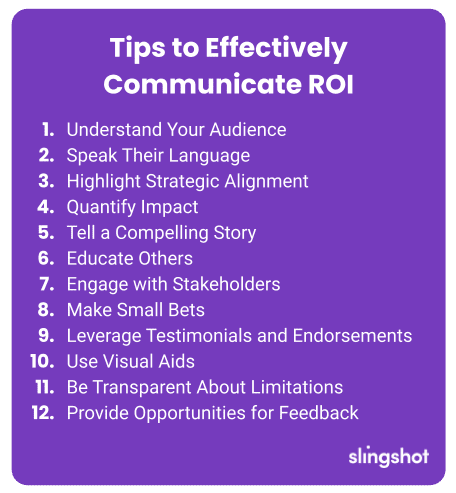So, you wanna implement AI in your business? Great! But it’s gonna take more than just saying, “I think we need AI.” You’ll have to justify that spending to your CEO, board, and investors.
You’ll need a lot of tools and tips to get from idea to reality. What challenges will you face? What metrics should you focus on? How can you effectively communicate it all?
Great questions, all of which we’ll dive into today!
Summary
- Challenges in Demonstrating AI ROI: Addressing hurdles like starting points, data quality, implementation costs, skill shortages, and establishing meaningful metrics amidst uncertainties.
- Measuring AI Impact: Balancing quantitative metrics such as cost savings and efficiency improvements with qualitative indicators like enhanced user experience and decision-making capabilities.
- Communicating ROI to Stakeholders: Tailoring communication strategies to stakeholder needs, using compelling stories and visual aids to illustrate AI’s financial and operational benefits.
Challenges in Demonstrating AI ROI
Demonstrating the Return on Investment (ROI) of any new initiative you’re bringing to your company is essential. You need to show that what you plan to do will provide value.
With AI, there’s a lot of desire to bring it on, but not as much information about its actual value. There are a bunch of hurdles that you might face while trying to showcase the ROI of AI. In this section, we’ll go through some of the most common challenges.
Where to Start?
One of the biggest hurdles when implementing AI is often figuring out where to begin. It’s essential to have a clear understanding of the capabilities of AI before diving into a project. Breaking down the target process into smaller, more manageable steps is a great way to ensure success.
Start by identifying a small, achievable goal that AI can accomplish. This will allow you to gain valuable experience and build confidence before tackling more intricate, complex projects. Remember, the key to success with AI is to start small and build gradually.
Data Quality and Availability
To ensure that AI models work well, they need high-quality data. But getting accurate data can be challenging due to data silos and the difficulty of getting real-time data. How to solve it? You may need to cleanse existing data or expand what’s being captured before implementing AI.
You may find that you aren’t capturing key decision points through a workflow that benefits training a machine learning algorithm. Last, don’t overlook images and documents. There are lots of algorithms available to analyze these as well.
Implementation Costs
Consider making your AI integration less jarring by initially focusing on the low-hanging fruit. Make small bets. Leverage available cloud services (AWS SageMaker, Azure ML, etc.) to reduce overall implementation costs. Remember that AI can help you save money in the long run (more on that later!).

No Baseline To Compare To
Before making the first change, you need to baseline the existing process to understand the time and cost of each step. This will help you determine where to focus your AI integration efforts and give you something to compare to after implementing changes.
Skill Shortages
Like any new tech, finding developers with the needed expertise is hard. Recruiting and holding onto qualified AI talent is difficult because everyone competes for them; There just ain’t enough to go around. To solve this issue, you have two options: focus on upskilling strategies and workforce development or hire a 3rd party with the skills to develop AI (Hi there! 👋).
Ambiguity in ROI Metrics
Measuring ROI is already a tricky concept. With something as buzzwordy or new as AI, it’s much worse. To show ROI, you gotta come up with clear and consistent metrics that match your business goals. It’s also crucial to customize metrics for specific Artificial Intelligence projects, like metrics for saving costs, boosting efficiency, or making more money, whatever your main goal is!
Fear of Uncertainty
AI is new and often misunderstood. If you’ve been in the business world for a while, you know that organizations have a lot of trouble embracing new technologies. Your first move should be to educate your organization on what AI truly is and how it may impact your organization. Once understood, the hope is that fear will subside, and you’ll find yourself brainstorming opportunities with the operations team.
To get people to accept change, you need to be open and honest with employees about the changes that will come with artificial intelligence. Try to create an environment where people are encouraged to experiment, learn, and grow as business people. One key point you need to make is that AI won’t take their jobs but will help make their jobs easier.
Measuring AI Impact
Demonstrating the impact of Artificial Intelligence goes beyond financial metrics; it encompasses quantitative and qualitative aspects that collectively showcase AI’s value to an organization. Let’s look at ways all the different factors you can use show the ROI for AI.
Quantitative metrics for assessing AI performance
Cost savings
AI implementation can save a lot of money by making operations more efficient. With AI, you can make your workflows smoother, eliminate repetitive tasks, and allocate resources better. Infrastructure expenses are also optimized through efficient resource utilization, helping reduce overall operational expenditure.
Scalability Improvements
AI can help you save time and improve your workflow. Some metrics that show this include faster decision-making, reduced processing times, and quicker response rates. As your business grows, you can do more with fewer resources.
Fewer Costly Mistakes
Minimize manual errors by utilizing AI to audit for mistakes as each item passes your process. Rather than having a highly experienced team audit a percentage of items, have AI audit all decisions. High quality is a competitive advantage.
Revenue generation
New money is always a good selling point! AI can create personalized recommendations and targeted marketing, getting your company in front of more qualified customers. You can increase sales and cross-selling opportunities by analyzing how AI enhances customer interactions. Tracking metrics related to sales growth, cross-selling, and customer retention rates are essential.
Qualitative indicators of AI success
Enhanced user experience
AI can improve user satisfaction and experience. AI can provide a personalized user experience, relevant suggestions based on past experiences, and 24/7 multi-lingual support. These all improve engagement and overall satisfaction. To measure the success of AI, you should look at user satisfaction metrics like user surveys and loyalty ratings. These metrics give you an idea of how users feel about their experience.
Improved decision-making
Can we talk about how AI helps make better decisions? AI provides data-driven insights to help you and your leadership team with strategic decision-making. With AI, you can access relevant information quickly and analyze data more effectively. The insights gained from AI will improve the quality and speed of critical decisions.

Employee Satisfaction and Collaboration
We mentioned it above, but we’ll say it again: AI tools can improve work life. AI can help with tedious tasks so that you can focus on more important things like strategy and planning. Using AI to eliminate routine work helps everyone feel more satisfied with their jobs. Did somebody say better retention rates? AI lets your team be creative and strategic, which is much more fun and rewarding.
Communicating ROI to Stakeholders
So, we’ve discussed the challenges you may face and the metrics you can use to showcase ROI for AI. But how do we go from idea to reality? You want to ensure everyone understands how AI will help your company reach its goals. Here are 12 tips to effectively communicate ROI.
- Understand Your Audience – Tailor messages to your stakeholders’ specific concerns and interests, adjusting the level of detail for each audience.
- Speak Their Language – Change how you present based on who you’re delivering to: highlight high-level ROI metrics in a business language for executives and provide technical insights on AI implementation for technical teams.
- Highlight Strategic Alignment – Emphasize how AI aligns with your overall business strategy and organizational goals.
- Quantify Impact – Quantify impact by clearly articulating quantitative metrics (like we shared earlier), like cost savings, efficiency gains, and revenue generation.
- Tell a Compelling Story Demonstrate how AI has improved the company’s financial performance using real-world examples, data visualizations, and engaging storytelling techniques.
- Educate Others – Show others what’s possible with AI. Doing so provides them the knowledge they need to assist with brainstorming where it makes sense.
- Engage with Stakeholders – Foster an open dialogue by encouraging questions and feedback from stakeholders during meetings, presentations, and workshops.
- Make Small Bets – Prove the value of AI by focusing on long-hanging fruit initially.
- Leverage Testimonials and Endorsements – Share testimonials from employees, customers, or industry experts to build credibility and reinforce the positive impact of your AI initiatives.
- Use Visual Aids – Incorporate visually appealing elements like charts, graphs, and infographics to convey complex information and enhance engagement.
- Be Transparent About Limitations – Acknowledge any limitations or challenges associated with AI implementation, demonstrating a proactive approach to addressing them.
- Provide Opportunities for Feedback – Create channels for stakeholders to provide feedback on AI initiatives, using this input to improve and refine your approach.

Conclusion
When implementing AI in your company, things will get complicated. But if you ensure your data is good, figure out how much it will cost, and find people who know how to utilize AI effectively, you’ll be all set. It’s a lot of work, but it’s worth it!
But what about the ROI side of things? Well, you have to look at complex numbers and other things like how happy your customers are. You’ll have to communicate the ROI of AI to multiple stakeholders effectively, but now you’re better equipped to do that!
If you can show people that AI is making a difference and how it can make a difference in your company, they’ll be more likely to support it. By working together and being open about your actions, you can make AI work for you and your company.
Want to Keep the AI Train Rolling?

Written by: Savannah
Savannah is our one-woman marketing department. She posts, writes, and creates all things Slingshot. While she may not be making software for you, she does have a minor in Computer Information Systems. We’d call her the opposite of a procrastinator: she can’t rest until all her work is done. She loves playing her switch and meal-prepping.

Edited by: Chris
Chris has been in the technology space for over 20 years, including being Slingshot’s CIO since 2017. He specializes in lean UX design, technology leadership, and new tech with a focus on AI. He’s currently involved in several AI-focused projects within Slingshot.




